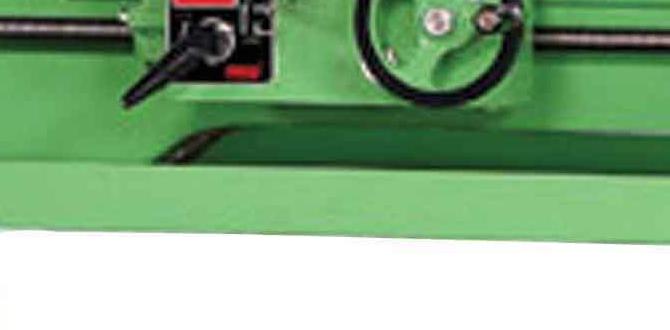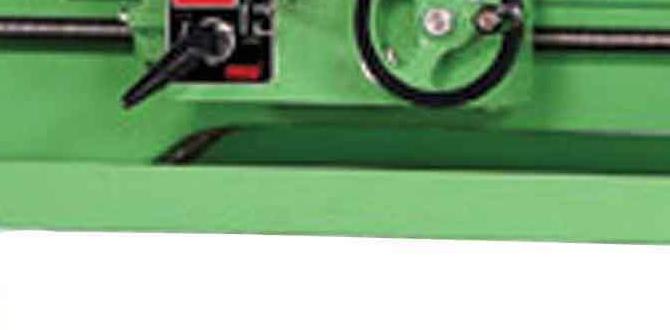Achieve a flawless copper mirror finish with a carbide end mill by using the right feed and speed, a sharp tool, and precise coolant application. This guide breaks down how to get that professional shine on your copper projects.
Getting a perfectly smooth, mirror-like finish on copper can feel like a machining mystery, especially for those new to metalworking. You might have tried different tools and techniques, only to end up with scratches, dull spots, or a finish that just doesn’t shine. Don’t worry, it’s a common challenge, but with the right approach, you can unlock that brilliant copper gleam. This guide will walk you through everything you need to know to achieve that effortless mirror finish using a carbide end mill. Get ready to transform your copper work!
Why Copper is Tricky (And How a Carbide End Mill Helps)
Copper is a wonderfully conductive and malleable metal, making it a popular choice for many projects, from electrical components and heat sinks to decorative art and jewelry. However, its softness and tendency to “gum up” tools make achieving a high-quality surface finish a real challenge. Standard end mills can easily dig in, chatter, or load up with copper chips, leaving behind a rough, undesirable surface.
This is where a carbide end mill shines, especially for copper. Carbide is an incredibly hard material, far harder than traditional high-speed steel (HSS). This hardness means it can maintain a sharp cutting edge longer, cut through materials more cleanly, and resist the tendency to load up with soft metals like copper. When paired with the right cutting parameters, a good quality carbide end mill can indeed deliver that sought-after mirror finish.
Understanding Your Carbide End Mill
Before we dive into the “how-to,” let’s quickly go over what makes up a carbide end mill and why certain types are better for specific jobs.
Types of Carbide End Mills for Copper
While there are many varieties of carbide end mills, for achieving a mirror finish on copper, you’ll primarily be looking at these:
Two-Flute (2-Flute) End Mills: These are often the go-to for softer metals like aluminum and copper. With fewer flutes, there’s more space for chips to evacuate, which is crucial when working with gummy materials. This helps prevent the tool from packing up with copper.
Ball Nose End Mills: If you’re aiming for smooth, contoured surfaces that will be polished to a mirror finish, a ball nose end mill is essential. The rounded tip allows for smooth, sweeping passes.
Square End Mills: For flat surfaces or creating sharp corners, a square end mill is used. While less common for pure “mirror polishing” compared to ball nose, they are used in the finishing stages.
Coating: Some carbide end mills come with specialized coatings (like AlTiN, TiCN, or even diamond coatings). For copper, a plain uncoated carbide or one with a specific slick coating designed for non-ferrous metals can be very effective. Coatings can improve tool life and chip evacuation.
Key Features to Look For:
Number of Flutes: As mentioned, 2-flute is often best for copper.
Material: Solid Carbide.
Shank: A sturdy shank (like 3/8 inch) provides rigidity, reducing vibration and improving surface finish.
Length: Long reach end mills can be helpful for accessing deeper features, but for general finishing, a standard length is usually fine.
Cut: “Uncoated” or “For Non-Ferrous Metals” are good indicators.
Essential Setup: Getting Ready for That Shine
A perfect finish isn’t just about the tool; it’s about the entire setup. A stable machine, proper workholding, and an effective coolant strategy are vital.
Machine Considerations
Rigidity: Your milling machine needs to be rigid. Any flex or vibration will translate into tool marks. Ensure your machine is well-maintained, with no excessive play in the ways or spindle.
Spindle Speed (RPM): You’ll need a machine that can achieve appropriate spindle speeds. Modern CNC machines are excellent, but even a manual mill with a good variable speed control can work.
Feed Rate Capability: Similarly, your machine needs to be able to maintain consistent feed rates.
Workholding: Secure Your Copper
Your copper workpiece must be held absolutely rigidly. Any movement during machining will ruin the finish.
Vise: A good quality milling vise that is properly squared to the machine’s axes is a common choice. Ensure the vise jaws are clean and that you’re not over-tightening, which can deform the copper.
Clamps: For larger parts or odd shapes, use clamps. Make sure they are positioned to provide strong support without obstructing the tool path.
Double-Sided Tape/Fixturing Plate: For very thin copper sheets, specialized fixturing techniques might be required, sometimes involving a sacrificial backing plate and strong double-sided tape.
Coolant and Lubrication: The Secret Weapon
This is critical for copper. Copper is soft and sticky; it loves to grab onto cutting tools. Lubrication is essential to:
Reduce friction: Minimizing heat buildup.
Prevent chip welding: Stop copper chips from sticking to the end mill flutes.
Improve surface finish: Act as a lubricant for a smoother cut.
Recommended Coolants/Lubricants for Copper:
Specialized Machining Fluids for Non-Ferrous Metals: These are designed to handle the unique properties of metals like copper and aluminum. Look for products formulated for high-speed machining and excellent lubricity. Brands like Master Fluid Solutions, Blaser Swisslube, or Houghton International offer suitable options.
Light Oils or Paraffin: For lighter work or manual machines, a light machine oil or even kerosene can work. Apply it frequently and directly to the cutting zone.
Aerosol Sprays: Some specialized sprays offer a convenient way to apply lubricant directly to the cutting edge.
Flood Coolant: On automated machines, flood coolant systems are ideal, providing constant lubrication and cooling.
Important Note on Coolant Application: You want to apply the coolant directly to the cutting zone where the end mill is interacting with the copper. This might involve a nozzle on a manual mill or the flood system on a CNC.
The “How-To”: Step-by-Step to a Mirror Finish
This section breaks down the process. We’ll assume you’re using a CNC mill for the most consistent results, but the principles apply to manual milling with careful attention.
Step 1: Select Your Carbide End Mill
Choose a 2-flute, solid carbide end mill. For a mirror finish, a bright or polished flute finish can also be beneficial. A common size to start with for many projects might be around 1/4″ or 3/8″ diameter with a appropriate shank, such as a carbide end mill 1/8 inch 3/8 shank long reach for copper mirror finish, if your project requires reaching into deeper areas. Even if it’s not “long reach” for your specific depth, the 3/8 shank provides excellent stability over a 1/8″ cutter diameter.
Step 2: Prepare Your CAM/Program
If you’re using a CNC, your CAM software is your best friend.
Toolpath Strategy: Use a finishing toolpath. For surfaces that will be polished, high-quality contouring or parallel finishing strategies are key. Avoid roughing passes that leave deep scallops.
Stepover: This is the distance you move the tool laterally between passes. For a mirror finish, you’ll want a very small stepover. This is often referred to as the “scallop height” when machining curved surfaces. A stepover of 0.0005″ to 0.002″ (0.012mm to 0.05mm) is typically what you’re aiming for. A smaller stepover means more passes but a much smoother surface requiring less post-machining work.
Stepdown: For the final finishing pass, it’s often best to take a very shallow depth of cut. Think 0.005″ to 0.010″ (0.12mm to 0.25mm) on tough materials, maybe slightly more on softer copper if the machine is rigid. The goal is to shave off a tiny amount of material to achieve smoothness.
Step 3: Set Your Cutting Parameters (Feed & Speed)
This is where experience and experimentation are crucial, as copper alloys can vary. Always start conservatively and increase gradually.
General Guidelines:
Surface Speed (SFM): For solid carbide cutting copper, a good starting point for surface speed is often in the range of 300-600 SFM (90-180 m/min). This will depend heavily on the specific alloy and the tool’s geometry.
Spindle Speed (RPM): To calculate RPM, use the formula:
`RPM = (SFM x 3.82) / Tool Diameter (inches)`
Or `RPM = (Surface Speed (m/min) x 1000) / (π x Tool Diameter (mm))`
Example: For a 1/4″ (6.35mm) end mill at 400 SFM:
`RPM = (400 x 3.82) / 0.25 = 6112 RPM`
Feed Rate (IPM): The feed rate is often more critical than SFM for achieving a good finish. It needs to be coordinated with chip load.
Chip Load: This is the thickness of the material being removed by each cutting edge of the end mill (per tooth). For copper with a 2-flute end mill, a chip load of 0.001″ to 0.003″ (0.025mm to 0.075mm) per tooth is a good starting point.
Feed Rate (IPM) Calculation:
`Feed Rate (IPM) = RPM x Number of Flutes x Chip Load per Tooth`
Example: Using the calculated 6112 RPM, with a 2-flute end mill and a chip load of 0.002″ per tooth:
`Feed Rate = 6112 x 2 x 0.002 = 24.45 IPM`
Table: Starting Point Cutting Parameters for 1/4″ 2-Flute Carbide End Mill in Copper
| Parameter | Value (Approximate) | Notes |
| :—————— | :—————— | :———————————————————————— |
| Surface Speed (SFM) | 400 | Can range from 300-600 SFM. Adjust based on tool wear and finish. |
| Spindle Speed (RPM) | 6112 | Calculated based on SFM and tool diameter. |
| Chip Load (IPT) | 0.002″ | Per tooth; critical for finish. Adjust for chip formation. |
| Feed Rate (IPM) | 24.5 | Calculated; aim for a consistent, non-chattering cut. |
| Depth of Cut (D.O.C.)| 0.005″ – 0.010″ | For final finishing passes. |
| Stepover (Radial) | 0.0005″ – 0.002″ | Crucial for surface smoothness and reducing polishing effort. |
| Lubrication | Essential | Apply generously via flood, spray, or mist to the cutting zone. |
Important Considerations:
Tool Diameter: Larger diameter end mills often require lower RPMs and higher feed rates to maintain the same chip load. The carbide end mill 1/8 inch would need proportionally higher RPM if using the same SFM.
Copper Alloy: Different copper alloys (e.g., pure copper, brass, bronze) have different machining properties. Be prepared to adjust.
Machine Capability: Never push your machine beyond its limits. If you hear chatter, the cut is too aggressive.
Test Cuts: Always perform test cuts on scrap material to dial in your parameters.
Step 4: Apply Lubrication Generously
As the end mill begins to cut, ensure your chosen lubricant is being applied directly to the cutting flutes and the copper surface. This is not optional for achieving a mirror finish on copper. Watch for the chips – they should be clean, small, and fall away easily, not cling to the tool. If they are, your feed rate might be too low, or you need better lubrication.
Step 5: Make the Finishing Passes
Light Depth of Cut: For your final finishing pass, especially if you’re aiming for a polishable surface, keep the depth of cut very light. This ensures the tool is essentially “shaving” the surface rather than taking a heavy cut.
Smooth Engagement/Disengagement: Ensure your CNC program (or your manual milling technique) has smooth entry and exit moves to avoid marking the surface. Plunge cuts should be minimized or done with a specific strategy.
Single Direction Passes: For the absolute best surface finish ready for polishing, some machinists prefer to make passes in a single direction on the final cut, rather than having the tool direction change on every pass. This can help align any microscopic surface irregularities in a uniform direction.
Step 6: Post-Machining Finishing (Polishing)
Even with perfect machining, you might have a finish that is very smooth but not yet a true mirror. This is where polishing comes in.
Deburring Tool: After machining, use a deburring tool to knock off any small burrs left on the edges.
Emery Cloth/Sandpaper: Start with a fine grit (e.g., 400-600 grit) and progressively move to much finer grits (e.g., 1000, 2000, even 4000 grit). Always move in one consistent direction, and for the final stages, use a polishing compound.
Polishing Compounds: A good metal polish or a jeweler’s rouge applied to a soft cloth or a buffing wheel can bring out that brilliant shine. Work the polish into the surface until it gleams.
Cleaning: Thoroughly clean the part with a degreaser or alcohol to remove all polishing residue.
Safety First: Always
Working with any machinery, especially milling, requires a keen eye on safety.
Eye Protection: Always wear safety glasses, preferably in a wrap-around style or with side shields.
Hearing Protection: Milling can be loud. Use earplugs or earmuffs.
No Loose Clothing or Jewelry: These can get caught in rotating machinery. Tie back long hair.
Machinery Guards: Ensure all guards are in place and functional.
Tooling Stability: Make sure your end mill is securely held in its collet or holder and that the holder is properly seated in the spindle.
Coolant Safety: Be aware of the flammability of some lubricants. Ensure good ventilation when using solvents or sprays. If using flood coolant, be mindful of slippery floors around the machine.
Read Machine Manuals: Always familiarize yourself with the specific safety features and operating procedures of your milling machine.
Common Problems and Solutions
Even with careful setup, you might encounter issues. Here’s how to tackle them:
Chatter:
Cause: Tool too long for diameter, insufficient spindle rigidity, feed rate too high, spindle speed too low, workpiece not held securely.
Solution: Use a higher quality, more rigid tool (e.g., stub length end mill if possible), reduce overhang, ensure workpiece is clamped rock solid, adjust feed and speed, increase the stiffness of the machine setup.
Gummy Chips/Tool Loading:
Cause: Insufficient lubrication, feed rate too low (creating rubbing rather than cutting), material properties.
Solution: Increase lubricant flow or switch to a better lubricant, increase feed rate to achieve proper chip load, ensure you’re using a tool designed for non-ferrous metals.
Scratches/Tool Marks:
Cause: Stepover too large, inconsistent feed rate, damaged tool, worn machine components, debris on the workpiece or tool.
Solution: Reduce stepover, ensure consistent feed, inspect and replace worn or damaged tooling, check machine for play, meticulously clean part and tooling.
Dull Finish (Not Mirror):
Cause: Stepover too large for the finishing pass, insufficient polishing effort, incorrect feed/speed leaving a micro-textured surface.
Solution: Reduce stepover further for the final machining pass, use finer grits of sandpaper/polishing compounds and adequate polishing time.
Optimizing for Your Specific Carbide End Mill
Let’s say you’ve found a specific tool like the carbide end mill 1/8 inch 3/8 shank long reach for copper mirror finish. How do you adjust?
Diameter (1/8″): Smaller diameters have a smaller cutting edge engaged at any given time. To achieve the same chip load, you’ll need a significantly higher spindle speed (RPM).
Example: For a 1/8″ (3.175mm) tool at 400 SFM:
`RPM = (400 x 3.82) / 0.125 = 12224 RPM`
This means you need a machine capable of high RPMs. The feed rate will also need adjustment:
`Feed Rate = 12224 RPM x 2 Flutes x 0.001″ Chip Load = 24.45 IPM` (Note: if you reduce chip load, feed rate goes down).
**




